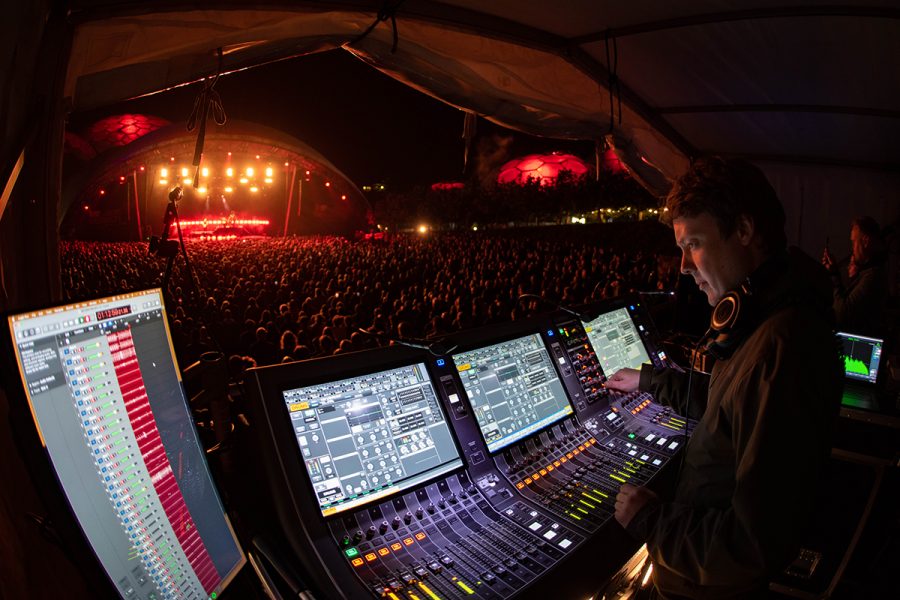Having scored a hat-trick of UK number one albums, this summer Royal Blood set off on a UK tour of headline and festival shows, before heading to Mexico. FOH Engineer, Phil Jones has discovered that the Yamaha RIVAGE PM5 digital mixing system offers many solutions to difficulties faced by tours in the early 2020s.
Many artists would be happy with a UK number one album but achieving the feat with your first three shows that Royal Blood are on to something special, despite the band’s minimalist line up of bass, drums and vocals.
Jones has known the band since its beginnings in the Brighton area. Previously he worked as Production and Tour Manager but, as the band’s shows grew from pubs to arenas, he increasingly focused on the sound.
“My aim is to make the sound as comfortably loud as possible,” he stated. “In the past, I used to tour a lot of gear. I wasn’t a fan of computers managing the sound, so I had twin 24u racks with outboard ranging from preamps and dynamic EQs for vocals to an array of dbx, TC Electronic, Eventide and Bricasti effects units.”
After being introduced to Yamaha RIVAGE PM digital mixing systems at the Neighbourhood Weekend festival in 2019, when the RIVAGE PM5 was launched in 2020, he took the opportunity to try it out on a broadcast recording session with the band, provided by long time supplier, Britannia Row Productions.
“I was so impressed that I adopted RIVAGE PM5 for my live setup and sold most of my outboard gear, including my H3000 and Bricasti reverb. I simply didn’t need them anymore,” he said.
The logistics and costs of touring in a pandemic, post-Brexit world are very different to what they were only a couple of years ago. As well as giving him the sonic quality and flexibility he needs, Jones has found that RIVAGE PM5 simplifies the process – and, importantly, lowers the expense – of global tours. “Due to the huge increase in demand for post-lockdown live music, we are flying all over the world. Venues are in such demand that we have to put together schedules that we wouldn’t normally undertake,” he commented.
With shipping having become so expensive, the team has discovered that it is often now cheaper to duplicate certain parts of the production and simply leave them in storage – in the US, for example. “Imagine if I still had to tour all that outboard gear… It would cost a fortune. Now we can just get another RIVAGE PM system and it has everything I need,” Jones commented. “We’ve been doing a similar experiment in streamlining Mike’s [Kerr, bass/vocals] amp setup on stage.”
For this and following tours, he said, the team will be using either Kemper or Quad Cortex modelling amps. “Not only will this make touring so much simpler, but there will be a significant reduction in SPL from the stage, which will allow me a lot more scope to fine tune the sound,” he said. Regarding the onboard sound shaping features of the RIVAGE PM system, not only was Jones able to replace his beloved hardware Bricasti reverb with the equally high-quality modelled version, but he has been impressed with the Rupert Neve Designs SILK emulation.
“I’m always a bit suspicious of marketing speak and at first, I thought that the RND SILK on the pre-amps was just hype. I was pleasantly surprised that it’s not – I use it on a number of channels,” he revealed.
Jones highlighted the fact that, no matter which size of control surface he uses, he can still benefit from the same pre-amps and plug-ins as other mixing boards. “I am pushing our rental house to get a RIVAGE PM3 control surface, because I recently mixed a Royal Blood gig at a small venue, and I turned up to find a bloody great RIVAGE PM7,” he smiled. “The local crew must have thought who the hell does this bloke think he is? A PM3 would have made me look far less egotistical.”
This article originally appeared in issue #266 of TPi, which you can read here.


